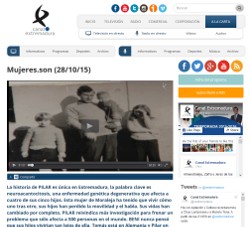In November 2015 Luis Ernesto Montero sent us this site to view a film about his family, narrated by his mother Pilar: Mujeres.son (28/10/15) | Canal Extremadura. This story was first broadcast on Spanish television in an interview with Pilar, a remarkable 77 year old mother of five children from Moraleja Spain. Four of her youngest children have neurocanthacytosis.
 From the film:
From the film:
"All four children started their lives as happy, healthy, creative young people, but as they reached their mid-20s, their parents were forced to watch them slowly lose their mobility, their speech and their independence.
Pilar’s life became an endless round of doctors, psychiatrists, conflicting diagnoses and grief. Carlos, her second son, drowned in a tragic accident. After Pilar’s husband died, she continued to dedicate her life to making sure her children were as comfortable as possible and to seeking out new research and technology that would help manage their condition to the best of their ability.
Luis Ernesto the oldest son and the only child to be completely free of the disease, had been living in London where he worked as an artist. He has now returned to Spain to help his mother take care of his siblings. While living in London, he found out about the website, naadvocacy.org which is dedicated to helping NA patients find out about the latest research and links for a network of contacts which support and inform others in similar situations.
Ernesto and Pilar work as a team to help their family and to raise awareness of neurocanthacytosis, of which there are less than 1000 reported cases worldwide. They both feel strongly about the urgent need for more research into this disease and the funding to make it possible.
Thanks to Pilar’s strength of purpose and total dedication, her youngest children are all well cared for by a team of dedicated professionals. Now, with modern technology and new medical discoveries they can enjoy family gatherings and the planning of exciting excursions in their future.”